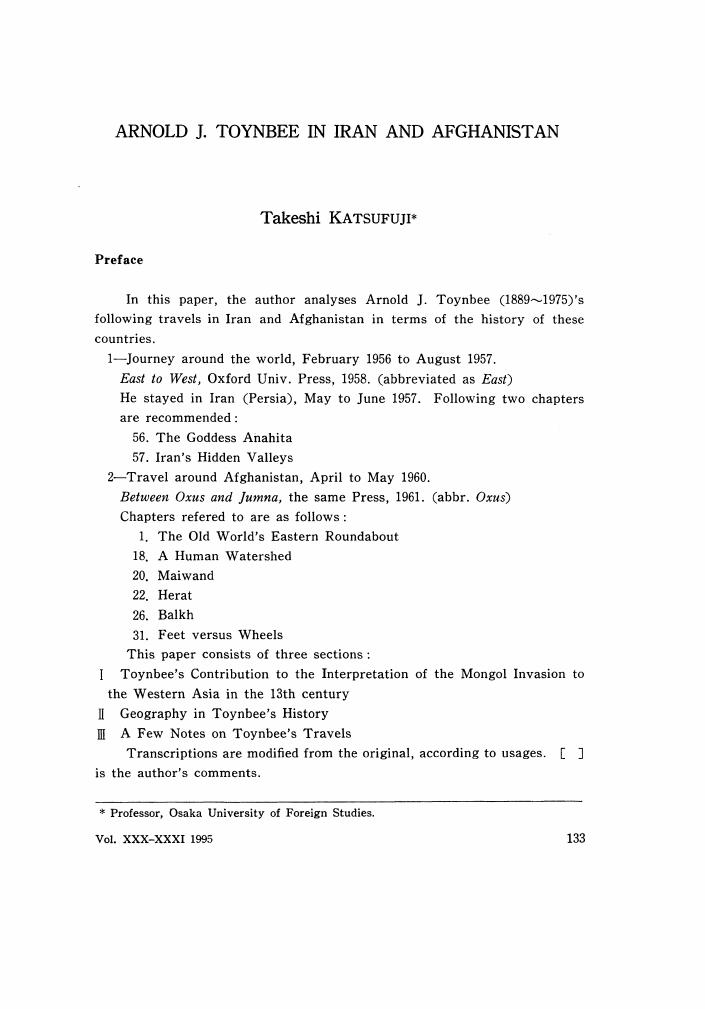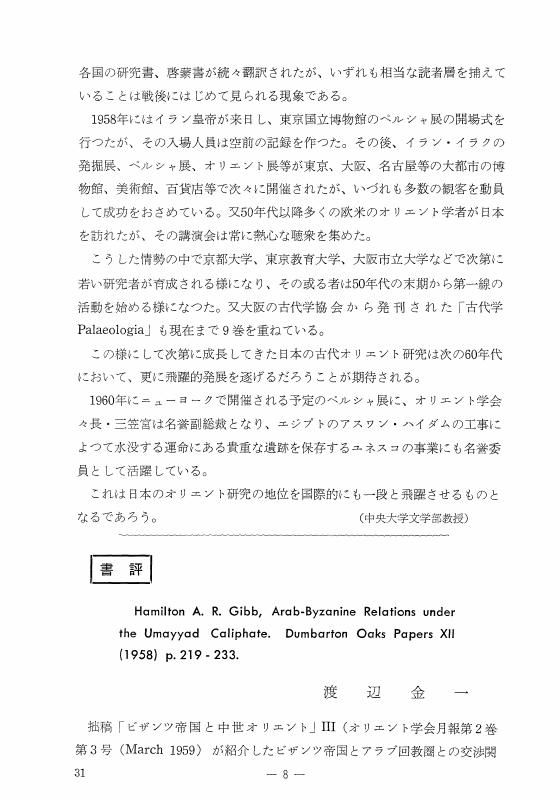1 0 0 0 OA ARNOLD J. TOYNBEE IN IRAN AND AFGHANISTAN
- 著者
- Takeshi KATSUFUJI
- 出版者
- The Society for Near Eastern Studies in Japan
- 雑誌
- Orient (ISSN:04733851)
- 巻号頁・発行日
- vol.30and31, pp.133-141, 1995 (Released:2009-02-12)
- 著者
- 屋形 禎亮
- 出版者
- The Society for Near Eastern Studies in Japan
- 雑誌
- オリエント (ISSN:00305219)
- 巻号頁・発行日
- vol.17, no.1, pp.125-129, 1974-09-15 (Released:2010-03-12)
- 著者
- Shin NOMOTO
- 出版者
- The Society for Near Eastern Studies in Japan
- 雑誌
- Orient (ISSN:04733851)
- 巻号頁・発行日
- vol.44, pp.19-39, 2009-03-31 (Released:2014-04-02)
- 参考文献数
- 60
- 被引用文献数
- 2 2
The fourth/tenth (A.H./C.E.) century is one of the most crucial time to the development of Ismā‘īlī Shī‘ism not only because the Fāṭimids’ claim for the sole leadership (Imāmah) conflicts with its original belief in the advent of the messianic figure called the Qā’im, but because some thinkers adopted Greek thought, especially Neoplatonism. This article aims at contributing to elucidation of how the Ismā‘īlī thinkers made consistent their doctrine on the Qā’im with newly adopted Neoplatonism in this important century, with special reference to Abū Ḥātim al-Rāzī’s (d. ca 322/933-4) Kitāb al-Iṣlāḥ, one of the oldest extant Neoplatonist-influenced texts. The text of al-Iṣlāḥ suggests that the Qā’im will resume the full contact, which Adam had enjoyed, with the two highest hypostases of Neoplatonist cosmology, that is, the Universal Intellect and the Universal Soul. Also in his text al-Rāzī implies that the advent of the Qā’im will mark or bring the full actualization of the “spiritual forms” (al-ṣuwar al-rūḥānīyah) and “simple form” (al-ṣurah al-basīṭah) of the human soul. This is also the result of the influence of the “highest simple world,” the realm of the two highest hypostases. Thus, with the background of Greek thought, especially Neoplatonism, al-Rāzī de-politicized the role and mission of the Qā’im. This idea is shared by al-Sijistani (d. after 361/971), Neoplatonist Ismā‘īlī thinker who is nearly one generation younger than al-Rāzī. Did this shared idea of the de-politicized and “spiritualized” Qā’im function as precursor for Ḥamīd al-Dīn al-Kirmānī’s (d. after 411/1020) own vision of the Qā’im and the postponing of his advent and the ultimate eschaton? This will be an issue of our future research.
- 著者
- Shigeru KAMADA
- 出版者
- The Society for Near Eastern Studies in Japan
- 雑誌
- Orient (ISSN:04733851)
- 巻号頁・発行日
- vol.30and31, pp.119-132, 1995 (Released:2009-02-12)
- 参考文献数
- 43
- 著者
- 渡辺 金一
- 出版者
- THE SOCIETY FOR NEAR EASTERN STUDIES IN JAPAN
- 雑誌
- 日本オリエント学会月報 (ISSN:18841384)
- 巻号頁・発行日
- vol.3, no.3, pp.31-36, 1960-06-05 (Released:2010-03-12)
1 0 0 0 OA "KHATA'I" MOTIF IN THE ISLAMIC ART
- 著者
- Minako YAMANLAR MIZUNO
- 出版者
- The Society for Near Eastern Studies in Japan
- 雑誌
- Orient (ISSN:04733851)
- 巻号頁・発行日
- vol.25, pp.96-118, 1989 (Released:2009-02-12)
- 参考文献数
- 76
1 0 0 0 OA Women and Palaces in the Neo-Assyrian Period
- 著者
- Francis JOANNÈS
- 出版者
- The Society for Near Eastern Studies in Japan
- 雑誌
- Orient (ISSN:04733851)
- 巻号頁・発行日
- vol.51, pp.29-46, 2016-03-30 (Released:2019-04-01)
- 参考文献数
- 44
The status of women in Neo-Assyrian palaces is well documented, and has been for a long time, through texts and archaeological finds. It reveals that what we could term the Queen’s Household as an institution was a powerful element of the Neo-Assyrian palatial system. Women who operate in the Queen’s Household possess an economic power that can be considerable. Every place where the Queen is present, and even every place where she owns large domains, generates a Queen’s Household with female staff used for service, production, and administration. On the royal administration’s model, these Queens’ Households are placed under the authority of an administrator-in-chief, the šakintu. This person manages and controls the finances of the House placed under her authority, as the Queen would herself do it, as in fact the lady of the house would in general. These šakintus rely both on the power that their function affords them, and on belonging to family or ethnic networks that are a useful complement to their economic role. This economic role is indeed not ordered along a male/female distinction only. The marriage of Ṣubētu, the daughter of the šakintu Amat-Astarti is a good example of the status and economic power of such a woman.
- 著者
- Nobuaki KUNIYA
- 出版者
- The Society for Near Eastern Studies in Japan
- 雑誌
- Orient (ISSN:04733851)
- 巻号頁・発行日
- vol.4, pp.17-36_6, 1967 (Released:2009-02-12)
- 参考文献数
- 67
- 被引用文献数
- 1 1
1 0 0 0 ジャーヒリーヤ時代の暦法:巡礼・交易・神聖月との関わりから
- 著者
- 医王 秀行
- 出版者
- The Society for Near Eastern Studies in Japan
- 雑誌
- オリエント (ISSN:00305219)
- 巻号頁・発行日
- vol.41, no.2, pp.20-37, 1998
In the Jahiliya Period, a pilgrimage festival with an annual market was held at a convenient season of the year. Observing the difference between the lunar and the solar year, they intercalated a month every several years. It has been said that this system was taken from the Jews. The Banu Kinana were charged with <i>Nasi'</i> (intercalation) and adjusted the calendar.<br>Abraha, who invaded Makka in the Year of the Elephant, aimed to divert the Arab pilgrimage to the church he himself had constructed in Yemen. But there were strong protests against his plan, particularly by the Kinanite who controlled the order of the Arab pilgrimage cycle in the Arabian peninsula.<br>According to their calendar, in a normal year, the first two months after Dhu 'l-Hijja were Safar I and Safar II, and in a leap year, the intercalary month, al-Muharram, came first, followed by Safar I and Safar II. Safar I in a normal year and al-Muharram both belonged to the sacred months, so that the safety of the pilgrims moving to another sanctuary was guaranteed. Therefore, in a leap year and a normal year, there were four sacred months.<br>Though this was exceptional, they postponed the sanctity of a month when the markets were invaded, or war broke out between Arab tribes, and so the festival could not be held as normal. Mainly the Kinanite took part in the war of Fijar which occurred near the 'Ukaz market for several years. Therefore, it was likely that the sacred month was postponed exceptionally.
1 0 0 0 OA CENTRAL ASIAN HISTORY
- 著者
- Kazuyuki KUBO
- 出版者
- The Society for Near Eastern Studies in Japan
- 雑誌
- Orient (ISSN:04733851)
- 巻号頁・発行日
- vol.38, pp.135-152, 2003 (Released:2008-03-24)
- 参考文献数
- 192
- 著者
- Akira USUKI
- 出版者
- The Society for Near Eastern Studies in Japan
- 雑誌
- Orient (ISSN:04733851)
- 巻号頁・発行日
- vol.29, pp.93-108, 1993 (Released:2009-02-12)
- 参考文献数
- 47
1 0 0 0 OA MISCELLANEA ON THE ACHAEMENID EMPIRE
- 著者
- SUSUMU SATO
- 出版者
- The Society for Near Eastern Studies in Japan
- 雑誌
- Orient (ISSN:04733851)
- 巻号頁・発行日
- vol.10, pp.21-30, 1974 (Released:2009-02-12)
- 参考文献数
- 58
1 0 0 0 OA SOME LUWIAN WORDS OF INDO-EUROPEAN ORIGIN
- 著者
- TERUMASA OSHIRO
- 出版者
- The Society for Near Eastern Studies in Japan
- 雑誌
- Orient (ISSN:04733851)
- 巻号頁・発行日
- vol.24, pp.47-54, 1988 (Released:2009-02-12)
- 参考文献数
- 46
- 著者
- SHIGERU KAMADA
- 出版者
- The Society for Near Eastern Studies in Japan
- 雑誌
- Orient (ISSN:04733851)
- 巻号頁・発行日
- vol.19, pp.7-28, 1983 (Released:2009-02-12)
- 参考文献数
- 52
- 被引用文献数
- 2 7
- 著者
- Seiro HARUTA
- 出版者
- The Society for Near Eastern Studies in Japan
- 雑誌
- Orient (ISSN:04733851)
- 巻号頁・発行日
- vol.28, pp.17-36, 1992 (Released:2009-02-12)
- 参考文献数
- 93
- 著者
- 西山 愛美
- 出版者
- The Society for Near Eastern Studies in Japan
- 雑誌
- オリエント (ISSN:00305219)
- 巻号頁・発行日
- vol.53, no.2, pp.149-155, 2011-03-31 (Released:2014-04-02)
1 0 0 0 OA THE CONCEPT OF THE "UMMAH" IN THE QUR'AN
- 著者
- YOSHIKO ODA
- 出版者
- The Society for Near Eastern Studies in Japan
- 雑誌
- Orient (ISSN:04733851)
- 巻号頁・発行日
- vol.20, pp.93-108, 1984 (Released:2009-02-12)
- 参考文献数
- 22
1 0 0 0 OA A STRUCTURAL ANALYSIS OF DHIKR AND NEMBUTSU
- 著者
- KOJIRO NAKAMURA
- 出版者
- The Society for Near Eastern Studies in Japan
- 雑誌
- Orient (ISSN:04733851)
- 巻号頁・発行日
- vol.7, pp.75-96, 1971 (Released:2009-02-12)
- 参考文献数
- 80
- 被引用文献数
- 1 1
1 0 0 0 OA ASSYRIOLOGY
- 著者
- Tohru MAEDA Kazuko WATANABE
- 出版者
- The Society for Near Eastern Studies in Japan
- 雑誌
- Orient (ISSN:04733851)
- 巻号頁・発行日
- vol.36, pp.35-56, 2001 (Released:2008-03-24)
- 参考文献数
- 222
This article is divided into two parts, the first covering the periods before 1500 B.C., that is, Sumerian, Old Babylonian, and Old Assyrian studies, and the second covering the periods after 1500 B.C., studies of the Middle Assyrian, Middle Babylonian, Neo-Assyrian, and Neo-Babylonian periods.
- 著者
- Yasuhiro YOKKAICHI
- 出版者
- The Society for Near Eastern Studies in Japan
- 雑誌
- Orient (ISSN:04733851)
- 巻号頁・発行日
- vol.50, pp.25-33, 2015-03-30 (Released:2018-04-01)
- 参考文献数
- 35
- 被引用文献数
- 1
The decree of Amīr Čoban dated 726 AH/1326 CE (National Library and Archives of the Islamic Republic of Iran, s.250) has four kinds of imprints, which consist of two āl-tamġā seals (vermilion seals) and two black seals. Among them, one is a square-shaped vermilion seal in Arabic script. Another is a square-shaped vermilion seal in ’Phags-pa and Arabic scripts. This document is a typical decree issued by a high-ranking great amīr because the āl-tamġā and qarā-tamġā seals were stamped on the prede ned places. However, it is the singular case in which a document is stamped with two kinds of āl-tamġā seal. Three of the four seals found on this decree were undoubtedly Amīr Čoban’s, and must have yielded the strongest authority to it.














